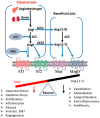Treatment with Angiotensin-(1-7) Prevents Development of Oral Papilloma Induced in K-ras Transgenic Mice
- PMID: 35409002
- PMCID: PMC8998511
- DOI: 10.3390/ijms23073642
Treatment with Angiotensin-(1-7) Prevents Development of Oral Papilloma Induced in K-ras Transgenic Mice
Abstract
Oral Squamous Cell Carcinoma (OSCC) is the most common malignant cancer affecting the oral cavity. It is characterized by high morbidity and very few therapeutic options. Angiotensin (Ang)-(1-7) is a biologically active heptapeptide, generated predominantly from AngII (Ang-(1-8)) by the enzymatic activity of angiotensin-converting enzyme 2 (ACE 2). Previous studies have shown that Ang-(1-7) counterbalances AngII pro-tumorigenic actions in different pathophysiological settings, exhibiting antiproliferative and anti-angiogenic properties in cancer cells. However, the prevailing effects of Ang-(1-7) in the oral epithelium have not been established in vivo. Here, we used an inducible oral-specific mouse model, where the expression of a tamoxifen-inducible Cre recombinase (CreERtam), which is under the control of the cytokeratin 14 promoter (K14-CreERtam), induces the expression of the K-ras oncogenic variant KrasG12D (LSLK-rasG12D). These mice develop highly proliferative squamous papilloma in the oral cavity and hyperplasia exclusively in oral mucosa within one month after tamoxifen treatment. Ang-(1-7) treated mice showed a reduced papilloma development accompanied by a significant reduction in cell proliferation and a decrease in pS6 positivity, the most downstream target of the PI3K/Akt/mTOR signaling route in oral papilloma. These results suggest that Ang-(1-7) may be a novel therapeutic target for OSCC.
Keywords: Ang-(1-7); K-ras; mTor; oral cancer; papilloma; tumor.
Conflict of interest statement
The authors declare no conflict of interest.
Figures




References
-
- Greco S., Muscella A., Elia M., Salvatore P., Storelli C., Mazzotta A., Manca C., Marsigliante S. Angiotensin II activates extracellular signal regulated kinases via protein kinase C and epidermal growth factor receptor in breast cancer cells. J. Cell Physiol. 2003;196:370–377. doi: 10.1002/jcp.10313. - DOI - PubMed
MeSH terms
Substances
Grants and funding
LinkOut - more resources
Full Text Sources
Medical
Molecular Biology Databases
Miscellaneous

